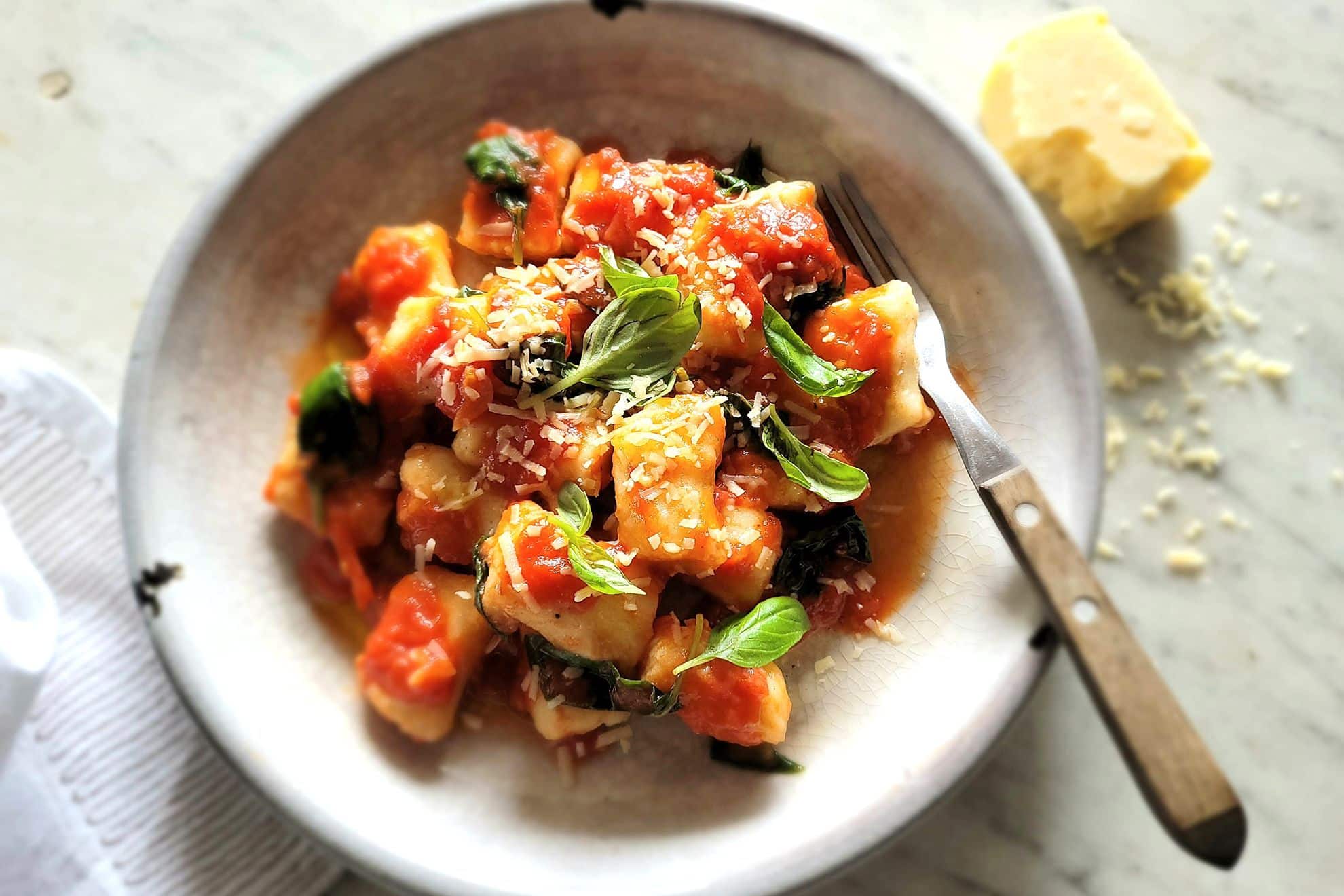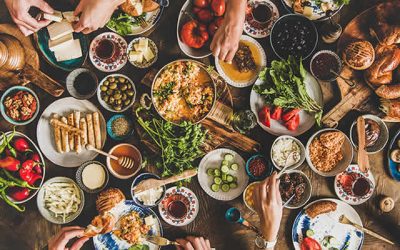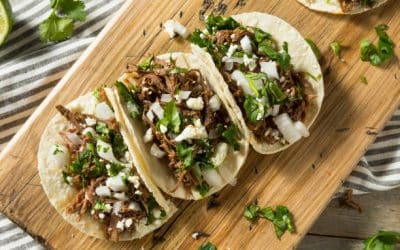Gnocchi is a delicious Italian dish made from soft potato dumplings. These delicate and pillowy morsels are versatile and can be served with various sauces or toppings.
The word “gnocchi” likely originates from the Italian term “nocca,” which translates to “knuckle” or “knot.”This term likely refers to the shape of the dumplings, which are often small, irregularly shaped, and resemble little knots.
Gnocchi has ancient roots in Italian cuisine, with various regional variations and recipes passed down through generations. Here’s a detailed description of the traditional gnocchi dish, its preparation, and some popular variations.
Traditional Gnocchi Ingredients for the Gnocchi
- 2 pounds (about 4 large) Russet or Yukon Gold potatoes
- 2 cups all-purpose flour, plus extra for dusting
- 1 large egg
- Salt
For Serving
- Your choice of sauce (e.g., marinara, brown butter and sage, pesto)
- Grated Parmesan cheese (optional)
- Fresh basil or parsley for garnish (optional)
Preparation
Preparing Italian gnocchi is a delightful process that doesn’t require a lot of specialized cookware. Gnocchi preparation is all about simplicity, and these basic kitchen tools are more than enough to create this classic Italian comfort dish. Enjoy your homemade gnocchi!
Cookware
- Pot You’ll need a large pot to boil the gnocchi and potatoes. A wide, shallow pot is ideal, as it allows you to cook them in a single layer without overcrowding. Make sure the pot is deep enough to hold an ample amount of water and has a lid.
- Slotted Spoon or Spider Strainer You use these utensils to gently lift the gnocchi out of the boiling water when they float to the surface.They allow excess water to drain back into the pot while transferring the cooked gnocchi to your sauce or a waiting plate.
- Mixing Bowl You’ll use a mixing bowl to combine the mashed potatoes, flour, and any other ingredients needed to make the gnocchi dough.
- Potato Masher or Ricer To prepare the mashed potatoes for the gnocchi dough, you can use a potato masher or a potato ricer. A ricer will result in smoother, lump-free potatoes.
- Bench Scraper or Knife This tool is helpful for cutting the gnocchi dough into manageable portions and shaping them into individual gnocchi.
- Flour Sifter or Fine-Mesh Strainer You might use one of these to lightly dust the work surface and the gnocchi dough with flour to prevent sticking during the shaping process.
- Baking Sheet or Tray To place the shaped gnocchi in a single layer and prevent them from sticking together before boiling, you can use a baking sheet or a tray lined with parchment paper.
- Fork or Gnocchi Board (optional) Some people like to give their gnocchi a textured surface for better sauce adhesion. You can use the tines of a fork or a specialized gnocchi board to create these patterns.
- Saucepan or Skillet Once you’ve boiled your gnocchi, you’ll probably use a saucepan or skillet to heat your chosen sauce and then toss the cooked gnocchi in it for a delicious coating.
- Plate or Serving Dish Finally, serve your cooked and sauced gnocchi on a plate or in a serving dish, garnished with your favorite toppings or herbs.
Preparing the Gnocchi
- Begin by boiling the whole, unpeeled potatoes until they are tender when pierced with a fork, usually about 45 minutes to 1 hour.
- Drain the potatoes and allow them to cool slightly until you can handle them comfortably but they’re still warm.
- Peel the potatoes while they’re still warm. Using a potato ricer or a fine mesh sieve, mash the peeled potatoes to create a smooth, lump-free consistency.
- Add the egg and a pinch of salt to the mashed potatoes and mix well.
- Gradually add the flour, one cup at a time, and gently knead the mixture until a soft, slightly sticky dough forms. Be careful not to over-knead; you want to avoid tough gnocchi.
- Divide the dough into smaller portions and roll each portion into a long, thin rope, about 1/2 inch (1.25 cm) in diameter.
- Cut the ropes into bite-sized pieces, typically about 1 inch (2.5 cm) in length.
- To shape the gnocchi, you can either use a fork to create ridges (roll each piece gently over the back of the fork) or leave them plain.
- Place the formed gnocchi on a floured baking sheet or tray to prevent sticking.
For Cooking
- Bring a large pot of salted water to a boil.
- Carefully drop the gnocchi into the boiling water in batches, using a slotted spoon.
- Cook the gnocchi until they float to the surface, which usually takes about 2-4 minutes.
- Remove the cooked gnocchi with a slotted spoon and transfer them to a serving dish.
Serving Gnocchi
- You can serve gnocchi with a variety of sauces. Some popular options include marinara sauce, brown butter and sage, creamy Alfredo sauce, or pesto.
- Top with grated Parmesan cheese and garnish with fresh basil or parsley, if desired.
Popular Variations of Gnocchi
- Ricotta Gnocchi -They use ricotta cheese instead of potatoes, creating a lighter and creamier variation.
- Spinach Gnocchi – They add spinach to the dough for a vibrant green color and a mild earthy flavor.
- Sweet Potato Gnocchi – They use sweet potatoes instead of regular potatoes, giving the gnocchi a subtly sweet taste and a beautiful orange color.
- Semolina Gnocchi (Gnocchi alla Romana) – Make these gnocchi from semolina flour and bake them in the oven. They have a unique texture and are typically paired with a cheese sauce.
- Gluten-Free Gnocchi – You can prepare gnocchi using gluten-free flour blends if you have dietary restrictions.
- Whole Wheat Gnocchi – You can use whole wheat flour to give gnocchi a heartier, nuttier flavor.
- Herb Gnocchi – You can add fresh herbs like basil, parsley, or chives to the dough for an extra burst of flavor.
- Gnocchi with Fillings Some variations feature stuffed gnocchi with fillings like cheese, mushrooms, or spinach.
Nutritional value
Here’s a general breakdown for a typical serving size (about 1 cup or roughly 150 grams) of potato-based gnocchi:
Nutritional Value of Gnocchi (for a 150g serving)
- Calories – 200-250 kcal
- Protein – 4-6g
- Total Fat – 0.5-2g
- Saturated Fat – 0-0.5g
- Carbohydrates – 45-50g
- Sugars – 1-2g
- Dietary Fiber – 2-4g
- Cholesterol – 20-40mg (if made with eggs; some recipes might not use eggs and would have 0mg cholesterol)
- Sodium – 10-50mg (varies based on preparation and if salt is added)
- Potassium – 300-500mg (from the potatoes)
- Calcium – 20-40mg
- Iron – 1-3mg
Some notes about gnocchi
- Gnocchi are relatively low in fat but are high in carbohydrates, primarily from the potatoes and flour.
- The protein content is moderate and comes mainly from the flour and, if used, the eggs.
- Gnocchi can be quite filling due to the dense nature of the dumplings.
Keep in mind that the above nutritional values are for plain gnocchi. The overall nutritional content of a dish can change significantly based on what you serve with the gnocchi, such as sauces (like marinara, pesto, or brown butter sage) or additional ingredients (like meats or other vegetables). Always consider the entire dish when assessing nutritional value.
Conclusion
Gnocchi are a delightful Italian comfort food, loved for their tender texture and ability to absorb various flavors from accompanying sauces. People adore gnocchi for their tender, melt-in-the-mouth texture and their wonderful ability to pair with a wide range of sauces. Whether you enjoy them in a traditional potato form or opt for one of the many variations, homemade gnocchi are a true Italian comfort food. Whether you choose the traditional recipe or one of the variations, homemade gnocchi are a treat to savor.
To discover more Italian dishes please see below.









0 Comments